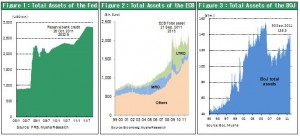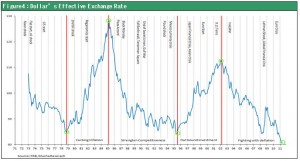The threat of a run on government bonds is over ? But a big risk-off correction is next
The true nature of the euro crisis was a 21st century-style run on government bonds. The 20th century-style financial crisis was a run on the banks. The Great Depression was caused by rumors of bankruptcy for even financially sound banks that triggered massive withdrawals and eventually bank failures. But now direct financing is the primary means of fund procurement. As a result, financial crises are sparked by sales of securities rather than withdrawals of bank deposits. If rumors lead to more rumors that fuel fears about instability irrespective of the facts, financial markets will make issuers of securities (whether they are countries or companies) bankrupt. The result of these chain reactions will be a financial panic.
Both the Lehman Brothers collapse and the current Greek/euro crisis reflect the ’pessimistic scenario’ that has little relationship with facts. Prices of securities plunged to a level at which there is no theoretical justification. The crisis reached a point at which it threatened the entire financial system. When financial markets are trapped in a vicious cycle in which selling fuels more selling, the time-consuming process of improving fundamentals (restoring financial soundness of companies and countries) is not very important. Above all, governments and central banks must decisively eliminate fears of declines in asset values among bank deposit holders and investors. Once the authorities demonstrate their commitment to pushing up asset prices, selling fueled by panic will inevitably come to an end. The reason is that central banks, which are the buyers propping up asset prices can print money. This gives the banks an unlimited supply of ammunition. Sellers will always lose because they will have to buy back their short positions. Covering short positions is what fueled the sharp rebound in prices of stocks and credit instruments following the 2009 collapse of Lehman Brothers. This same rebound is about to take place again following the Greek debt and euro crisis. As a result, a major correction involving risk-off positions will most likely support a virtuous cycle that causes prices of assets to climb.
Extreme financial easing in US and Europe increases the likelihood of an expansion of the central banks’ balance sheets
Last Friday, we heard a number of high-ranking people at the Fed say that QE3 may be needed. The Fed is responsible for controlling inflation as well as for creating jobs and supporting the economy. These statements demonstrated the Fed’s unwavering commitment to improving the housing market, which is the greatest obstacle to an economic recovery. In other words, the Fed is determined to use an unlimited amount of funds (which means the Fed will keep using funds until its objective is achieved) to increase prices of mortgage-backed securities (which means reducing the risk premium). Big downturns in support for the Tea Party and Republican Party, both of which were critical of the Fed’s monetary easing, is another favorable development for enacting further easing measures.
At the EU Summit that just ended, agreement was reached on establishing a system, together with the EFSF and ECB, for buying the bonds of southern European countries that are currently being sold off. China as well is prepared to implement its own monetary easing to support the economy after inflation peaks and before the transition to a new leadership takes place. Consequently, another round of global monetary easing is about to begin. In addition, fears about the outflow of capital from emerging countries by the contraction of bank balance sheets in the euro zone will probably halt.
The yen’s strength will not last long
Monetary easing in the US and Europe has caused the yen alone to strengthen among the world’s major currencies. Currently, the yen is at a record high. The yen’s strength is a natural reflexive reaction of the market. But I think this strength will not last very long. First, the BOJ will be forced to enact monetary easing on the same scale as in the US and Europe. Second, the US is firmly resolved to implement more monetary easing. Stock prices will climb and a broad-based economic recovery will begin as this easing takes place. These events will finally reverse the prolonged decline of the dollar that began in 2002. Third, the yen’s appreciation was accompanied by growth in risk off positions by global investors. As investors close out risk off positions, they will sell back their yen holdings.
Moreover, the US GDP expanded at an annualized rate of 2.5% in the third quarter of 2011 according to preliminary data. This report greatly reduced the lingering fears among investors of a double-dip recession in the United States. After taking all these factors into consideration, investors should probably adopt the view that the world’s financial markets are on the verge of a major turning point.





